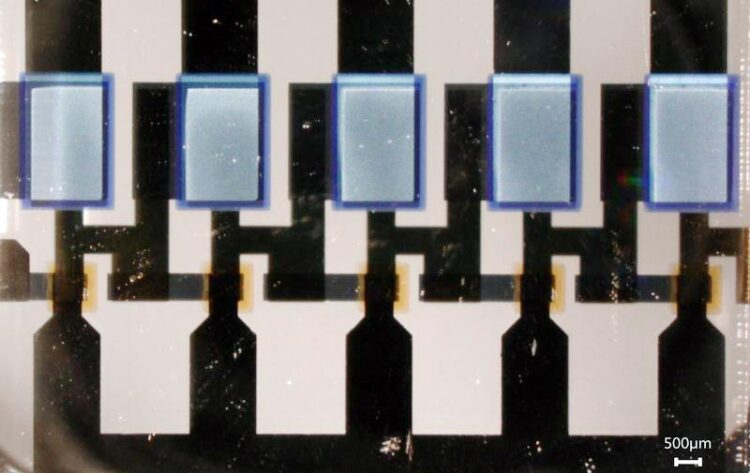Organic electronics possibly soon to enter the GHz-regime

Image of a 5-stage complementary ring-oscillator composed of organic permeable base transistors.
(c) Dr. Erjuan Guo
Physicists of the Technische Universität Dresden introduce the first implementation of a complementary vertical organic transistor technology, which is able to operate at low voltage, with adjustable inverter properties, and a fall and rise time demonstrated in inverter and ring-oscillator circuits of less than 10 nanoseconds, respectively. With this new technology they are just a stone’s throw away from the commercialization of efficient, flexible and printable electronics of the future. Their groundbreaking findings are published in the renowned journal “Nature Electronics“.
Poor performance is still impeding the commercialization of flexible and printable electronics. Hence, the development of low-voltage, high-gain, and high-frequency complementary circuits is seen as one of the most important targets of research. High-frequency logic circuits, such as inverter circuits and oscillators with low power consumption and fast response time, are the essential building blocks for large-area, low power-consumption, flexible and printable electronics of the future.
The research group “Organic Devices and Systems” (ODS) at the Institute of Applied Physics (IAP) at TU Dresden headed by Dr. Hans Kleemann is working on the development of novel organic materials and devices for high performance, flexible and possibly even biocompatible electronics and optoelectronics. Increasing the performance of organic circuits is one of the key challenges in their research. It was only some month ago, when PhD-student Erjuan Guo announced an important breakthrough with the development of efficient, printable, and adjustable vertical organic transistors.
Now, building on their previous findings, the physicists demonstrate for the first time vertical organic transistors (organic permeable base transistors, OPBTs) integrated into functional circuits. Dr. Hans Kleemann and his team succeeded in proving that such devices possess reliable performance, long-term stability, as well as unprecedented performance measures.
„In previous publications, we found that the second control-electrode in the vertical transistor architecture enables a wide-range of threshold voltage controllability, which makes such devices become ideal for efficient, fast and complex logic circuits. In the recent publication, we add a vital feature to the technology by demonstrating complementary circuits such as integrated complementary inverters and ring-oscillators. Using such complementary circuits, the power- efficiency and speed of operation can be improved by more than one order of magnitude and might possibly allow organic electronics to enter the GHz-regime”, explains Erjuan Guo, who meanwhile received a Ph.D. with distinction from Technische Universität Dresden.
The complementary inverters and ring-oscillators developed at the IAP represent a milestone towards flexible, low-power GHz-electronics as it would be needed, for example in wireless communication applications. “Furthermore, our findings might inspire the entire research community to envision alternative vertical organic transistor designs as they seem to enable high-frequency operation and low-cost integrated at the same time”, adds Erjuan Guo enthusiastically.
###
Original Publication:
Erjuan Guo, Shen Xing, Felix Dollinger, René Hübner, Shu-Jen Wang, Zhongbin Wu, Karl Leo, Hans Kleemann. ‘Integrated complementary inverters and ring oscillators based on vertical-channel dual-base organic thin-film transistors’, Nature Electronics. https:/
All latest news from the category: Physics and Astronomy
This area deals with the fundamental laws and building blocks of nature and how they interact, the properties and the behavior of matter, and research into space and time and their structures.
innovations-report provides in-depth reports and articles on subjects such as astrophysics, laser technologies, nuclear, quantum, particle and solid-state physics, nanotechnologies, planetary research and findings (Mars, Venus) and developments related to the Hubble Telescope.
Newest articles

Innovative 3D printed scaffolds offer new hope for bone healing
Researchers at the Institute for Bioengineering of Catalonia have developed novel 3D printed PLA-CaP scaffolds that promote blood vessel formation, ensuring better healing and regeneration of bone tissue. Bone is…

The surprising role of gut infection in Alzheimer’s disease
ASU- and Banner Alzheimer’s Institute-led study implicates link between a common virus and the disease, which travels from the gut to the brain and may be a target for antiviral…

Molecular gardening: New enzymes discovered for protein modification pruning
How deubiquitinases USP53 and USP54 cleave long polyubiquitin chains and how the former is linked to liver disease in children. Deubiquitinases (DUBs) are enzymes used by cells to trim protein…


